Located in the San Bernardino Mountains just five minutes west of Big Bear Lake Village, Cedar Lake today is a year-round camp that serves 8,000 people a year. Historically, however, Cedar Lake has had a long and exciting past as a film location site.
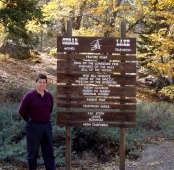 Surrounded by a National Forest, at an elevation of 7,100 feet, Cedar Lake dates back to the 1890s when it was initially purchased by the Talmage brothers as a place for cattle to graze. In 1922, they sold the land to the Bartlett brothers. The Bartletts wanted to subdivide the land for sale and felt that building a lake on the property would increase its value. Therefore, in 1929, they constructed a 30-foot dam forming the three-and-a-half acre Cedar Lake. Realizing the popularity of the lodges and resorts in nearby Big Bear Valley, Guy Bartlett, one of the brothers' sons, bought the property in 1937 in the hope of developing a resort of his own (see Big Bear). Failing in this pursuit, he began promoting Cedar Lake as a tourist attraction and charged a 25-cent admission to enter the property. Part of the tourist appeal stemmed from the use of Cedar Lake as a film location site for the movie industry starting in the early to mid-1930s. Over the years, many Hollywood Studios including 20th Century Fox, Columbia, Paramount, Republic and Warner Brothers would use this location as a backdrop for their big screen productions.
Surrounded by a National Forest, at an elevation of 7,100 feet, Cedar Lake dates back to the 1890s when it was initially purchased by the Talmage brothers as a place for cattle to graze. In 1922, they sold the land to the Bartlett brothers. The Bartletts wanted to subdivide the land for sale and felt that building a lake on the property would increase its value. Therefore, in 1929, they constructed a 30-foot dam forming the three-and-a-half acre Cedar Lake. Realizing the popularity of the lodges and resorts in nearby Big Bear Valley, Guy Bartlett, one of the brothers' sons, bought the property in 1937 in the hope of developing a resort of his own (see Big Bear). Failing in this pursuit, he began promoting Cedar Lake as a tourist attraction and charged a 25-cent admission to enter the property. Part of the tourist appeal stemmed from the use of Cedar Lake as a film location site for the movie industry starting in the early to mid-1930s. Over the years, many Hollywood Studios including 20th Century Fox, Columbia, Paramount, Republic and Warner Brothers would use this location as a backdrop for their big screen productions.
One of the earliest documented movies to be filmed at Cedar Lake was Henry Hathaway's To the Last Man (1933) starring Randolph Scott and Esther Ralston.
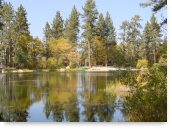 Soon, other screen productions followed including In Person (1935) starring Ginger Rogers and George Brent; Girl of the Ozarks (1936) starring Virginia Weidler and Henrietta Crosman; Straight from the Shoulder (1936) starring Ralph Bellamy and Katherine Locke; George B. Seitz' screen production of James Fenimore Cooper's novel, The Last of the Mohicans (1936), starring Randolph Scott and Binnie Barnes; and Henry Hathaway's The Trail of the Lonesome Pine (1936) starring Henry Fonda and Fred MacMurray. The Trail of the Lonesome Pine is the classic story of feuding families and the various changes that occur when a railroad is built on their land. Previously filmed in 1915,
Soon, other screen productions followed including In Person (1935) starring Ginger Rogers and George Brent; Girl of the Ozarks (1936) starring Virginia Weidler and Henrietta Crosman; Straight from the Shoulder (1936) starring Ralph Bellamy and Katherine Locke; George B. Seitz' screen production of James Fenimore Cooper's novel, The Last of the Mohicans (1936), starring Randolph Scott and Binnie Barnes; and Henry Hathaway's The Trail of the Lonesome Pine (1936) starring Henry Fonda and Fred MacMurray. The Trail of the Lonesome Pine is the classic story of feuding families and the various changes that occur when a railroad is built on their land. Previously filmed in 1915,
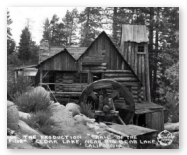 Hathaway's version became the first outdoor feature to be filmed in full (3-color) Technicolor. The film is often mistaken as the first full Technicolor film of any sort; however that designation actually belongs to Becky Sharp (1935), which was released in 1935. Other major films to utilize Cedar Lake include Untamed (1940), starring Ray Milland and Patricia Morison, which was George Archainbaud's Technicolor remake of Clara Bow's Mantrap (1926); Henry Hathaway's Brigham Young - Frontiersman (1940) starring Tyrone Power and Linda Darnell, and Shepherd of the Hills (1941) starring John Wayne and Harry Carey; and Raoul Walsh's High Sierra (1941) starring Ida Lupino and Humphrey Bogart. Henry Hathaway apparently had quite a penchant for Cedar Lake, for at least four of his major productions were filmed here.
Hathaway's version became the first outdoor feature to be filmed in full (3-color) Technicolor. The film is often mistaken as the first full Technicolor film of any sort; however that designation actually belongs to Becky Sharp (1935), which was released in 1935. Other major films to utilize Cedar Lake include Untamed (1940), starring Ray Milland and Patricia Morison, which was George Archainbaud's Technicolor remake of Clara Bow's Mantrap (1926); Henry Hathaway's Brigham Young - Frontiersman (1940) starring Tyrone Power and Linda Darnell, and Shepherd of the Hills (1941) starring John Wayne and Harry Carey; and Raoul Walsh's High Sierra (1941) starring Ida Lupino and Humphrey Bogart. Henry Hathaway apparently had quite a penchant for Cedar Lake, for at least four of his major productions were filmed here.
With its mighty pines, rustic log cabins, and crystal clear waters, it is no wonder that Cedar Lake often doubled on the silver screen for such far away places as the Ozarks or the scenic
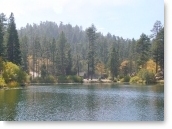 Canadian Northwest and Yukon Territory. As a result, several Mountie-themed films and serials have been filmed at Cedar Lake, many of which were screen adaptations of stories by the prolific novelist and Michigan-native, James Oliver Curwood. The Mountie cliffhangers that have taken advantage of the beautiful Cedar Lake scenery include Republic Pictures' 12-chapter King of the Mounties (1942) directed by William Witney and starring Allan Lane, and Dangers of the Canadian Mounted (1948) directed by Fred Brannon and starring Jim Bannon; Universal Pictures' 13-chapter The Royal Mounted Rides Again (1945) directed by Ray Taylor and starring Bill Kennedy; and Columbia Pictures' 15-chapter Gunfighters of the Northwest (1954) directed by Spencer Gordon Bennet and starring Jock Mahoney. In the early 1950s, Kirby Grant starred in a Northwest Mountie film series for Monogram/Allied Artists Pictures that included nine entries that were filmed at Cedar Lake:
Canadian Northwest and Yukon Territory. As a result, several Mountie-themed films and serials have been filmed at Cedar Lake, many of which were screen adaptations of stories by the prolific novelist and Michigan-native, James Oliver Curwood. The Mountie cliffhangers that have taken advantage of the beautiful Cedar Lake scenery include Republic Pictures' 12-chapter King of the Mounties (1942) directed by William Witney and starring Allan Lane, and Dangers of the Canadian Mounted (1948) directed by Fred Brannon and starring Jim Bannon; Universal Pictures' 13-chapter The Royal Mounted Rides Again (1945) directed by Ray Taylor and starring Bill Kennedy; and Columbia Pictures' 15-chapter Gunfighters of the Northwest (1954) directed by Spencer Gordon Bennet and starring Jock Mahoney. In the early 1950s, Kirby Grant starred in a Northwest Mountie film series for Monogram/Allied Artists Pictures that included nine entries that were filmed at Cedar Lake:
 The Wolf Hunters (1949), Snow Dog (1950), Call of the Klondike (1950), Yukon Manhunt (1951), Northwest Territory (1951), Yukon Gold (1952), Fangs of the Arctic (1953), Northern Patrol (1953), and Yukon Vengeance (1954). Also in the 1950s, Hollywood's famous singing cowboy, Gene Autry, used Cedar Lake in
several of his Columbia Pictures' oaters including Gene Autry and the Mounties (1951) and Blue Canadian Rockies (1952), with the latter being mostly a B-Western theme movie highlighting a dude ranch. Other B-Westerns to use Cedar Lake as a film locale include William "Hoppy" Boyd's Riders of the Timberline (1941), Russell Hayden's Riders of the Northwest Mounted (1943), Gene Autry's Riders of the Whistling Pines (1949), and Roy Rogers' North of the Great Divide (1950) and Trail of Robin Hood (1950), both directed by William Witney and filmed in beautiful Trucolor. In the concluding scene of the horror flick Giant from the Unknown (1958), a 400-year-old,
lightning-bolt-revived, depraved giant of a man known as Vargas the Conquistador (Buddy Baer) is finally put to rest as he falls off Cedar Lake's dam during a struggle of good over evil.
The Wolf Hunters (1949), Snow Dog (1950), Call of the Klondike (1950), Yukon Manhunt (1951), Northwest Territory (1951), Yukon Gold (1952), Fangs of the Arctic (1953), Northern Patrol (1953), and Yukon Vengeance (1954). Also in the 1950s, Hollywood's famous singing cowboy, Gene Autry, used Cedar Lake in
several of his Columbia Pictures' oaters including Gene Autry and the Mounties (1951) and Blue Canadian Rockies (1952), with the latter being mostly a B-Western theme movie highlighting a dude ranch. Other B-Westerns to use Cedar Lake as a film locale include William "Hoppy" Boyd's Riders of the Timberline (1941), Russell Hayden's Riders of the Northwest Mounted (1943), Gene Autry's Riders of the Whistling Pines (1949), and Roy Rogers' North of the Great Divide (1950) and Trail of Robin Hood (1950), both directed by William Witney and filmed in beautiful Trucolor. In the concluding scene of the horror flick Giant from the Unknown (1958), a 400-year-old,
lightning-bolt-revived, depraved giant of a man known as Vargas the Conquistador (Buddy Baer) is finally put to rest as he falls off Cedar Lake's dam during a struggle of good over evil.
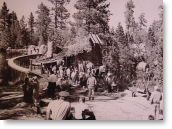 During the 1960s, several light-hearted movies were filmed at Cedar Lake including Walt Disney's The Parent Trap (1961) starring Hayley Mills and Maureen O'Hara, and Paramount's Kissin' Cousins (1964) starring Elvis Presley and Arthur O'Connell. In this latter Gene Nelson film, Cedar Lake and the old mill house are easily recognizable as Elvis Presley sings to the cousins, Pam Austin and Yvonne Craig, along the side of the lake where Camp Fire #1 is located today. At the end of the song sequence, Elvis and the two cousins actually go into the old mill house and lean on the water wheel. This is the same mill house set built 28 years ago for the filming of The Trail of the Lonsesome Pine (1936). In addition to appearing in many big screen features, Cedar Lake has also appeared in many television productions including Adventures of Wild Bill Hickok, The Range Rider, The Roy Rogers Show, Bonanza, Lassie, The F.B.I., and Hart to Hart.
During the 1960s, several light-hearted movies were filmed at Cedar Lake including Walt Disney's The Parent Trap (1961) starring Hayley Mills and Maureen O'Hara, and Paramount's Kissin' Cousins (1964) starring Elvis Presley and Arthur O'Connell. In this latter Gene Nelson film, Cedar Lake and the old mill house are easily recognizable as Elvis Presley sings to the cousins, Pam Austin and Yvonne Craig, along the side of the lake where Camp Fire #1 is located today. At the end of the song sequence, Elvis and the two cousins actually go into the old mill house and lean on the water wheel. This is the same mill house set built 28 years ago for the filming of The Trail of the Lonsesome Pine (1936). In addition to appearing in many big screen features, Cedar Lake has also appeared in many television productions including Adventures of Wild Bill Hickok, The Range Rider, The Roy Rogers Show, Bonanza, Lassie, The F.B.I., and Hart to Hart.
For a number of years in the 1940s, especially during the summers and holidays, several hundred tourists visited Cedar Lake on a daily basis. Guy Bartlett, who bought the property in 1937, had built two cottages and a house, stocked the lake, rented boats, and charged a fee for fishing. But as the 1950s began, Bartlett had increasing difficulty turning a profit.
Coincidentally, in 1954 the First Congregational Church of Los Angeles, with the hopes of increasing its youth membership, began looking for an attractive camping program in the San Bernardino Mountains. A scouting party consisting of the senior pastor, Dr. James Fifield, William Stoufer and others visited several Lake Arrowhead properties without much success. Guy Bartlett's accountant suggested Cedar Lake as a possibility, and after the group visited the property they were captivated by its serene beauty.
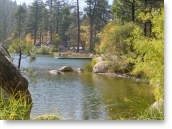 In January 1955, the Church purchased the 110-acre property at a cost of $160,000. Later that same year, a second parcel of land was purchased, which increased the total area of the Cedar Lake property to its current 270-acre size.
In January 1955, the Church purchased the 110-acre property at a cost of $160,000. Later that same year, a second parcel of land was purchased, which increased the total area of the Cedar Lake property to its current 270-acre size.
Since 1955, the camp's grounds and facilities have seen tremendous improvements. In 1962, after hearing a radio message by Dr. Fifield, Lillian Herriman donated funds in memory of her son, Morris, to build "Herriman Lodge", a kitchen and dining facility that seats 120 people. Rhone Lodge, with a meeting room and lodging for 44 people, was built in the 1970s.
Other notable improvements include the building of the 300-capacity Stoufer Amphitheatre in 1984 and the building of the Fifield Chapel in 1991, using the same design and location of the old mill house found in such movies as The Trail of the Lonesome Pine (1936), Trail of Robin Hood (1950), and Kissin' Cousins (1964). Recently built is Scanland Hall, a meeting facility for 200 people.
The First Congregational Church of Los Angeles still owns and operates Cedar Lake Camp, and for twenty-seven years Ron Robillard served as Camp Manager.
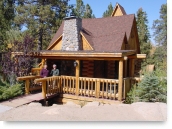 In 2008, Ron's son Jason, following in his father's footsteps, became the camp's Manager. Visitors can fish, boat and ski in the pristine 5-acre clear water lake, and hike along nature trails that wind through spectacular Ponderosa pine forests. The area is also rich with Native American and pioneer history, which allows for a variety of program options. Some of the educational highlights available include mountain and riparian ecology, geology, astronomy, and wildlife viewing. Surrounded by unsurpassed natural beauty in the San Bernardino Mountains and offering exceptional outdoor experiences, Camp Cedar Lake is an outstanding retreat center and one of the finest camping facilities in Southern California.
In 2008, Ron's son Jason, following in his father's footsteps, became the camp's Manager. Visitors can fish, boat and ski in the pristine 5-acre clear water lake, and hike along nature trails that wind through spectacular Ponderosa pine forests. The area is also rich with Native American and pioneer history, which allows for a variety of program options. Some of the educational highlights available include mountain and riparian ecology, geology, astronomy, and wildlife viewing. Surrounded by unsurpassed natural beauty in the San Bernardino Mountains and offering exceptional outdoor experiences, Camp Cedar Lake is an outstanding retreat center and one of the finest camping facilities in Southern California.
To reach Cedar Lake Camp from the Los Angeles area, take I-10 Freeway east and exit at CA-30 west at Redlands (sign reads To Big Bear and Running Springs). Proceed approximately 3 miles and exit right onto CA-330. At Running Springs, follow CA-18 into Big Bear. Cross over the dam at Big Bear Lake and, after passing Boulder and Metcalf Bays on the left and the Town Hall/Performing Arts Center on the right, go approximately two-tenths of a mile and turn right onto Tulip Lane. Go approximately ¼ mile, past the USFS campground, and turn right onto Mill Creek Road. Follow Mill Creek Road until the pavement ends. Continue on the gravel road and follow the sign into Cedar Lake Camp.